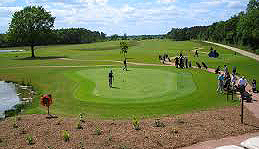
An example of what some golf courses are doing to reduce turf: decorative plants and ground cover replace grass areas around the practice green.
As the golf industry continues to search for more efficient use of costly water resources, Pascuzzo & Pate is getting to the heart of the matter with its creative ideas on turf reduction, which translates water conservation – an issue that isn’t going away anytime soon in places like California.
Recently completed designs at Crow Canyon Country Club in Danville, as well as Braemar Country Club in Tarzana and Porter Valley Country Club in Northridge, Pascuzzo & Pate not only have identified areas of turfgrass that can be removed, but are redesigning those areas to be visually pleasing to players and homeowners, while maintaining the integrity of the golf course design.
“We are finding that on most courses, there are 18-20 acres of turfgrass that can be removed,” Damian said. “Most water districts offer rebates of roughly $2 per square foot, which can result in significant savings on water expenses.”
At Aliso Viejo Country Club in Orange County, Calif., Pascuzzo & Pate have identified close to 25 acres of turfgrass that can be removed, which is roughly 1 million square feet.
When analyzing a turf-reduction program, Pascuzzo & Pate first look for areas that are largely out of play, then areas such as secondary cuts of the rough, or rough that is close to teeing areas. At Porter Valley Country Club, while renovating the fairway bunkers, Pascuzzo & Pate transformed many of them into more expansive, yet playable, waste areas.
Reduction of 20 acres of turf can result in an annual water savings of 12-15 million gallons of water in mild to warm climates.”
“That is the future of the golf industry, even in areas that we think of as having plenty of rainfall,” Damian said. “But it’s more than just removing grass; you have to be aware of the local water district’s guidelines and take that into consideration when determining what you is going to replace the turf.”


